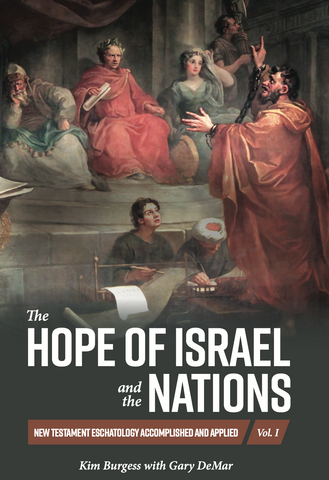Now that the first volume of the book is available, this recap from the initial episodes of Covenant Hermeneutics and Biblical Eschatology was due for a re-run.
New Testament eschatology is the eschatology of Old Testament Israel. Israel’s eschaton is what is being discussed there. But, of course, Israel’s eschaton was a subset of the greater world history. OT Israel was not the end of the road. Israel was a God-ordained means to an end—to deal with a bigger problem, and that problem is Adam and the Fall; namely, the “sin, condemnation, and death” that came because of Adam’s sin (Rom 5:12-19). God chose to create and use OT Israel to concentrate sin there so that sin could be dealt with once and for all time there (5:20-21), which is why the Old Covenant order existed (cf. Gal. 3:19). Paul tells us this in Romans 5 and 7, to deal with sin through Israel’s Messiah, Jesus. So that then the Kingdom of God could come into the world, so that then the application of this redemption could go to the world (the Gentile nations). Eschatology, then, is woven into the whole thing. Biblical eschatology is not just the last chapter in the Systematic theology manual or the last few questions and answers in the catechism.
The Abrahamic Covenant never passes away. It is fulfilled in Christ and His eternal New Covenant order. This is why the epistle to the Hebrews is so important. I think that the most important document in the Bible, especially in the New Testament, is Hebrews because it is quintessentially a Biblical- theological book; it is a covenantal, redemptive-historical book. All of it rests on Abraham and what was promised to Abraham in the covenant made with him.
But then the author of Hebrews (Note: my best guess is that Apollos wrote Hebrews) moves into talking about a “first” and a “second” Covenant, but that does not mean a “Covenant of Works” and a “Covenant of Grace” which is what the Westminster Confession of Faith does with it. No, the “first Covenant” in that situation is Moses, the Mosaic/Sinaitic/Old Covenant order. The “second Covenant” is the New Covenant order in the person and work of Christ. Both the Old and the New Covenants are reflections, in their own respective ways, of what was promised to Abraham. In the first Covenant—that is with Moses—it is a typological, that is, a fleshly, earthly, literal, physical, material—whatever word you want to use here—and temporary manifestation of what those promises to Abraham were. Whereas the New Covenant is the Heavenly, Spiritual, eternal fulfillment, the antitype of all that was typified in the Old Covenant order. That is how it all hangs together.

The Hope of Israel and the Nations
The reader and student of the Bible must first understand the content of the New Testament writings in terms of how those in the first century would have understood it. The New Testament is written against the background of the Old Testament. The shadows of the Old were fulfilled in the reality of the New. All the rituals and ceremonies were fulfilled in Jesus. The same is true of the temple, land, blood sacrifices, the nature of redemption, the resurrection of the dead, the breaking down of the dividing wall dividing Jews and Gentiles, and so much more. The New Testament's emphasis is on the finished work of Jesus and its application, not only to that Apostolic generation but to the world today.
Buy NowGary summarizes the initial two podcasts from the Covenant Hermeneutics and Biblical Eschatology series with Kim Burgess. Now that the first volume of the book is available, this recap was due for a re-run. While many people were enthused and appreciative of the interviews, others have taken issue with them. Gary explains the theological method of reading and interpreting the Bible on its own terms and some questions that arise from reading Scripture in light of Scripture.

